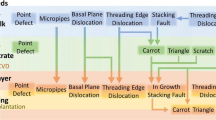Abstract
Ion implantation is the most useful technology for doping of 4H silicon carbide to fabricate power devices. Semiconductor properties depend on implanted doping activation and ionization, and these properties are critical for the proper design and modeling of SiC power devices. In 4H-SiC, during activation annealing, the atomic diffusion rate is low, and thus full dopant activation is not readily achieved. Also, dopants in 4H-SiC are observed to have very deep energy levels. The temperature behavior of the electrical characteristics depends on the ionization energy level, and these values are not adequately characterized in 4H-SiC over all doping levels. To improve device modeling accuracy and device design predictive capabilities as a function of temperature and doping levels, further study of the behavior of dopants in SiC is crucial. Due to its demonstrated usefulness in epitaxial n-type SiC growth, nitrogen is the element most frequently employed in device manufacturing for n-type doping. However, phosphorus can serve as an alternative, with ionization energies expected to be close to nitrogen. In this work, electrical characterization of phosphorus-implanted 4H-SiC is examined as a function of doping and temperature. For this purpose, four-point van der Pauw probes are prepared, and resistivity and Hall measurements are carried out. Resistivity values are observed to decrease as temperature and doping concentration increase. Concerning Hall mobility, at low temperatures, the Hall mobility decreases due to increased impurity scattering, while at very high temperatures, it decreases because of increased phonon scattering. The increase in carrier concentration with the increase in temperature indicates incomplete ionization and relatively deep ionization energies. From the obtained data, a two-level charge neutrality equation is used to extract and compare the activation percentage and ionization energies for dopants in hexagonal and cubic sites. For a doping level of ~ 3.2 × 1018 cm−3, dopant ionization energy levels of 82 meV and 40 meV are found for the cubic and hexagonal sites, respectively, and these are observed to be a function of doping concentration. The extracted activation rate and ionization energies are useful for improving the predictive capability of SiC device modeling.








Similar content being viewed by others
References
T. Kimoto and J.A. Cooper, Fundamentals of silicon carbide technology (Singapore: Wiley, 2014).
J. Pernot, W. Zawadzki, S. Contreras, J.L. Robert, E. Neyret, and L. Di Cioccio, Electrical transport in n-type 4H silicon carbide. J. Appl. Phys. 90, 1869 (2001).
M.A. Capano, J.A. Cooper Jr., M.R. Melloch, A. Saxler, and W.C. Mitchel, Ionization energies and electron mobilities in phosphorus- and nitrogen-implanted 4H-silicon carbide. J. Appl. Phys. 87, 8773 (2000).
C. Darmody and N. Goldsman, Incomplete ionization in aluminum-doped 4H-silicon carbide. J. Appl. Phys. 126, 145701 (2019).
F. Schmid and G. Pensl, Comparison of the electrical activation of P+ and N+ ions co-implanted along with Si+ or C+ ions into 4H-SiC. Appl. Phys. Lett. 84, 3064 (2004).
W. Gotz, A. Schoner, G. Pens, W. Suttrop, W.J. Choyke, R. Stein, and S. Leibenzeder, Nitrogen donors in 4H-silicon carbide. Appl. Phys. 73, 3332 (1993).
F. Schmid, M. Laube, G. Pensl, G. Wagner, and M. Maier, Electrical activation of implanted phosphorus ions in (0001)- and (11–20)-oriented 4H-SiC. J. Appl. Phys. 91, 11 (2002).
M. Laube, F. Schmid, G. Pensl, G. Wagner, M. Linnarsson, and M. Maier, Electrical activation of high concentrations of N+ and P+ ions implanted into 4H–SiC. J. Appl. Phys. 92, 1 (2002).
J. Senzaki, K. Fukuda, and K. Arai, Influences of post implantation annealing conditions on resistance lowering in high-phosphorus-implanted 4H–SiC. J. Appl. Phys. 94, 5 (2003).
Y. Negoro, K. Katsumoto, T. Kimoto, and H. Matsunami, Electronic behaviors of high-dose phosphorus-ion implanted 4H–SiC (0001). J. Appl. Phys., 96, 1, (2004).
M. Laube, F. Schmid, G. Pensl, and G. Wagner, Codoping of 4H-SiC with N- and P-Donors by ion implantation. Mater. Sci. Forum 389–393, 791 (2002).
A.F. Silva, J. Pernot, S. Contreras, B.E. Sernelius, C. Persson, and J. Camassel, Electrical resistivity and metal-nonmetal transition in n-type doped 4H-SiC. Phys. Rev. B 74, 245201 (2006).
D.J. Lichtenwalner, J.H. Park, S. Rogers, H. Dixit, A. Scholtze, S. Bubel, and S.H. Ryu, Temperature dependent electrical properties of n-type 4H-SiC substrates. Trans Tech Publ. 1089, 3–7 (2023).
Author information
Authors and Affiliations
Corresponding author
Ethics declarations
Conflict of interest
The authors do not have any conflicts of interest to disclose.
Additional information
Publisher's Note
Springer Nature remains neutral with regard to jurisdictional claims in published maps and institutional affiliations.
Rights and permissions
Springer Nature or its licensor (e.g. a society or other partner) holds exclusive rights to this article under a publishing agreement with the author(s) or other rightsholder(s); author self-archiving of the accepted manuscript version of this article is solely governed by the terms of such publishing agreement and applicable law.
About this article
Cite this article
Das, S., Lichtenwalner, D.J., Dixit, H. et al. Study of Dopant Activation and Ionization for Phosphorus in 4H-SiC. J. Electron. Mater. 53, 2806–2810 (2024). https://doi.org/10.1007/s11664-024-10976-3
Received:
Accepted:
Published:
Issue Date:
DOI: https://doi.org/10.1007/s11664-024-10976-3




